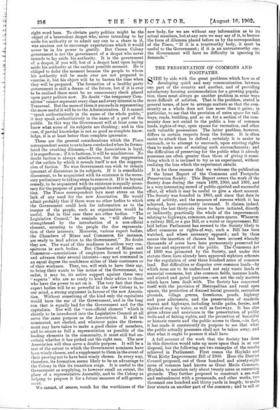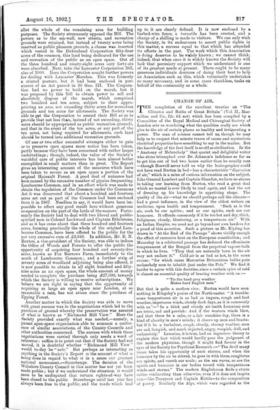THE PRESERVATION OF COMMONS AND FOOTPATHS.
than to make sure of resisting such encroachments ; and the difficulties of preserving for the public what it already possesses are often greater than those of giving it some- thing which it is inclined to try as an experiment, without realising the loss which the experiment entails.
It is for these reasons that we welcome the publication of the latest Report of the Commons and Footpaths Preservation Society. This Report covers the work of the Society done during the years 1899, 1900, and 1901, and is a very interesting record of public-spirited and successful effort, of which it may be useful to give a short account. The Society was founded in 1865, and since that date ite area of activity, and the measure of success which it haE achieved, have consistently increased. It claims, indeed, during the last thirty-six years to have initiated, directly or indirectly, practically the whole of the improvements relating to highways, commons, and open spaces. Whenever a railway Bill, or a gas Bill, or a water or improvement Bill laid before Parliament has seemed to the Society likely to affect commons or rights-of-way, such a Bill has been watched, and where necessary opposed ; and by these means the insertion of clauses has been secured whereby thousands of acres have been permanently preserved for the use and enjoyment of the public. The Commons Act of 1899 was promoted by the Society, and under this statute there have already been approved eighteen schemes for the regulation of over three hundred acres of common land. But difficulties or disputes over common lands—by which term are to be understood not only waste lands or manorial commons, but also common fields, lammas lands, and stinted and gated pastures—are not the only matters which have been dealt with. The Society has concerned itself with the provision of Metropolitan and rural open spaces, the protection of disused burial grounds, recreation grounds, village greens, foreshores, ponds, highway and poor allotments, and the preservation of roadside wastes and highways, including bridle paths, ferries, and rights-of-way by water, as well as footways. It has also given advice and assistance in the preservation of public wells and of fishing rights, and the protection of beautiful or historic resorts and the public access to them,—in fact, it has made it consistently its purpose to see that what the public actually possesses shall not be taken away, and that what it ought to possess it shall have.
A full account of the work that the Society has done in this direction would take up more space than is at our disposal, but the following are two examples of the results achieved in Parliament. First comes the Hoylake and West Kirby Improvement Bill of 1900. Here the District Council proposed, out of three hundred and ninety-eight acres of common land known as Great Meols Common, Hoylake, to maintain only about twenty acres as recreation grounds. They further proposed to construct a sea-wall and embankment with a promenade, and other works, two thousand one hundred and thirty yards in length; to make four streets on another part of the common ; and to sell or allot the whole of the remaining area for building purposes. The Society strenuously opposed the Bill. The powers as to the sea-wall, new streets, and recreation grounds were retained, but instead of twenty acres being reserved as public pleasure grounds, a clause was inserted which vested in the Birkenhead Corporation fifty-four acres of the common, this land being dedicated for the use and recreation of the public as an open space. Out of the three hundred and ninety-eight acres only forty-six were absorbed. Next, take the Lancaster Corporation Bill, also of 1900. Here the Corporation sought further powers for dealing with Lancaster Marshes. This was formerly a stinted pasture, but it had been enclosed in pur- suance of an Act passed in 36 Geo. III. The Corpora- tion had no power to build on the marsh, but it was proposed by this Bill to obtain power to sell and absolutely dispose of the marsh, which comprised two hundred and ten acres, subject to their appro- priating an area not exceeding thirty acres for recreation grounds and ten acres for allotments. The Society was able to got the Corporation to amend their Bill so as to provide that not less than, instead of not exceeding, thirty acres should be appropriated as public recreation grounds, and that in the event of the ten acres, or any part of the ten acres, not being required for allotments, such land should be turned into additional recreation grounds.
Of one or two other successful attempts either to gain or to preserve open spaces more notice has been taken, partly because they have been concerned with rather larger undertakings ; though, indeed, the value of the Society's watchful care of public interests has been almost better exemplified in small matters than in great. The Report gives an interesting account of the measures which have been taken to secure as an open space a portion of the original Hainault Forest. A good deal of nuisance had been caused by the excessive number of gipsies frequenting Lambourne Common, and in an effort which was made to obtain the regulation of the Common under the Commons Act it was discovered that about a hundred and fourteen acres set out as part of the Common had been enclosed from it in 1867. Needless to say, it would have been im- possible to effect any good result here without generous co-operation on the part of the lords of the manors. Fortu- nately the Society had to deal with two liberal and public- spirited men in Colonel Lockwood and Captain Ethelstone, and so it has come about that three hundred and fourteen acres, forming practically the whole of the original Lam- bourne Common, have been offered to the public for the not very excessive sum of £3,640. In addition, Mr. E. N. Buxton, a vice-president of the Society, was able to induce the Office of Woods and Forests to offer the public the opportunity of acquiring four hundred and seventy-five acres, known as Fox Burrows Farm, immediately to the south of Lambourne Common ; and a further strip of seventy acres of woodland adjoining being also offered, it is now possible to obtain in all eight hundred and fifty- nine acres as an open space, the whole amount of money needed to complete the purchase being £27,000, towards which the Society is willing to receive subscriptions. We believe we are right in saying that the opportunity of acquiring so large an open space near London, at so reasonable a rate, has not arisen since the purchase of Epping Forest.
Another matter in which the Society was able to move with great success was in the negotiations which led to the purchase of ground whereby the preservation was assured of what is known as " Richmond Hill View." Here the Society provided exactly what was needed,—namely, a parent open-space organisation able to summon a confer- ence of similar associations, of the County Councils and other authorities concerned. The success with which these negotiations were carried through only needs a word of reference : suffice it to point out that if the Society had not moved, it is doubtful whether " Richmond Hill View " would to-day • be " safe." But perhaps as interesting as anything in the Society's Report is the account of what is being done in regard to what is in a sense our greatest national monument,—Stonehenge. The decision of the Wiltshire County Council in this matter has not yet been made public ; but if we understand the situation, it would seem to be undisputed that certain rights-of-way have been closed to the public. Stonehenge until last year has always been free to the public, and the roads which lead up to it are clearly defined. It is now enclosed by a barbed-wire fence, a turnstile has been erected, and a charge of a shilling is made to visitors. We can only wish the Society, in its endeavours to assert public rights in this matter, a success equal to that which has attended its efforts in the past. The work which this Association is doing deserves to be widely known ; we cannot think, indeed, that when once it is widely known the Society will lack that pecuniary support which we understand is one of its greatest needs at present. There ought to be many generous individuals desirous of doing their best to help an Association such as this, which voluntarily undertakes so many necessary, and in some cases thankless, tasks on behalf of the community as a whole.



































 Previous page
Previous page